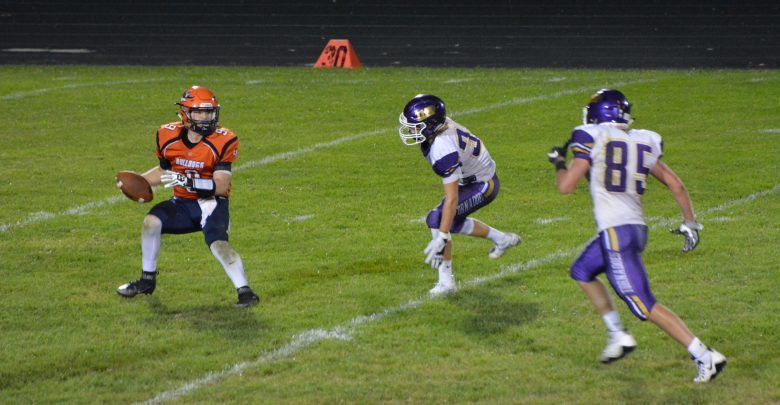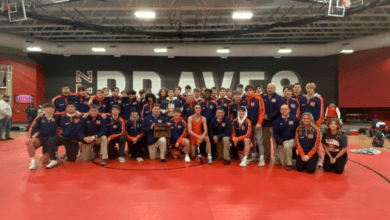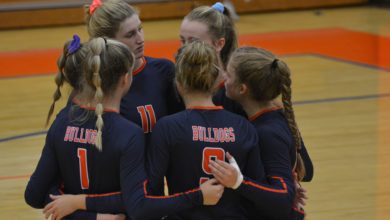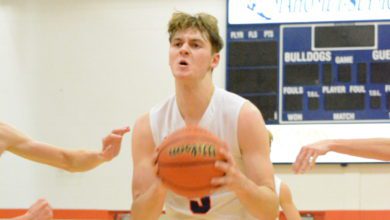IHSA football districts approved

By FRED KRONER
fred@mahometnews.com
In another 32 months, the structure of the high school football playoffs in Illinois will change dramatically.
Those changes — which are no longer proposed, but are confirmed — will be the most sweeping since the postseason format was introduced in the sport in 1974.
As announced by the Illinois High School Association on Dec. 18, all football-playing schools in the state will be divided into either eight-team or nine-team districts (and assigned by the IHSA) with the top four teams in each of those districts qualifying for the playoffs.
Only district games will be used to determine playoff eligibility.
The approved plan does not add more teams or more classes to the playoffs.
There will still be eight divisions for football with 32 teams competing in each of the classes. A total of 256 schools will participate in the playoffs.
Schools will know prior to the start of the 2021 season which class they fall into for a two-year period. The districts they will be assigned to will be as similar as possible in enrollments.
While some coaches and administrators welcome the changes, others are more dubious.
The Mahomet Daily contacted representatives from Mahomet-Seymour, Oakwood, St. Joseph-Ogden and Villa Grove/Heritage on Friday seeking their feedback.
The IHSA could not be reached as it is on Winter Break until January, 2019.
For most of the past two decades, there has been at least one proposal on the ballot for school administrators to consider that would alter the football playoffs. Proposals very similar to the one which passed this year were voted on — and rejected — in 2009 and 2014.
This year’s vote marked the first time any change was approved beyond increasing the number of classes and the location for the state championship games. The 2018 measure passed 324-307, with 69 “no opinion” votes.
The successful proposal was submitted by members of the IHSA’s football advisory committee.
“I’m honestly not sure what made this proposal different than in years past,” Oakwood coach Al Craig said. “I think when you look at the landscape of high school football in Illinois, most teams were in a conference that they were happy with and conferences that had been around for a long time.
“However, there were a few schools that were really struggling and having to play schools from Missouri and such. I also think some people were unhappy playing in conferences that didn’t fit. So that had a lot to do with the change in voting.”
Heath Wilson, the Villa Grove/Heritage head coach, didn’t expect the response.
“To be honest, I’m shocked with the outcome,” Wilson said. “I would love to see who voted for it because everyone I talked to said they were going to vote to keep the current system. I’ve never seen a plan that was better than what we currently have.”
Some administrators have speculated that after so many years of seeing ideas to change the football setup, it was time to approve something.
“I am not surprised that we are moving towards this,” SJ-O head coach Shawn Skinner said. “I think there has been a belief that going to district play will help to minimize conference relocation and reorganization.
“There is also a belief that some schools will have a more equal opportunity to gain playoff berths now that they are going to be playing teams from their own class size as opposed to playing schools one-to-two classes above and below.”
Mahomet-Seymour athletic director Matt Hensley was aware of increased support for altering the football format.
“It just got to the point scheduling issues were impacting more and more schools on an annual basis,” Hensley said. “There’s enough concerns with the current system, it’s time to see what other options are out there.”
One reason for concerns for the future, Hensley acknowledges, is the uncertainty.
“It’s difficult for people to wrap their heads around what the districts will look like,” he said. “That’s an unknown, and that can be scary.”
While the change is guaranteed, many questions remain unanswered. Will there be all-District teams? Will district champions receive a trophy or plaque?
Then, there’s this:
One interpretation of the announcement that the pre-district games won’t count as anything more than preparation leads to the belief that ultimately when playoff teams are seeded, some 8-1 teams will be seeded lower than some 7-2 teams.
To illustrate, Team A wins both non-district games, but is 6-1 within the district, making an overall record of 8-1.
Team B loses both of its non-district games, but is 7-0 within the district, making an overall record of 7-2.
However, since the non-district games aren’t part of the postseason equation, the two-loss team that won all of its district games would earn a higher seed.
“We really have a lot of questions that were not answered for us by the IHSA,” Skinner said. “What will our district be the first two years? How will they seed the playoffs?
“How will they determine who hosts postseason games? How will they determine home and away schedules in our districts? Many questions and concerns that coaches and schools have could be helped if the IHSA would provide a mock-up of the districts based on the previous year.”
Hensley will have plenty of issues to address as he looks ahead. How can he hire quality officials in advance if the schedule for 2021 is not released until around Christmas of 2020?
“This is not a perfect solution,” Hensley said. “Very few are, but this is the first path on a journey.
“There’s some work to be done. This is the first time any of those proposals have gotten any traction and this sets us on a journey different from the past. It’s not the final draft.”
In its release of the impending changes, the IHSA announced the issue would be revisited after the first two years. It’s possible big or small changes could be made again prior to the 2023 season.
“I think this will take multiple tweaks to get corrected,” Skinner said. “But I think this has been the direction we were heading for a while. Too many other states use it and we will see how our administrators and coaches like it.
“As we experience some of the negatives to how we have set it up, I think there is the potential to act fast early on as we plan to redistrict every two years. That means you can adjust fairly quickly when concerns come up.”
Still, in the first week of contemplating the new plan, Skinner can think of areas to address.
“My biggest frustration stems from having two games that essentially don’t count,” he said. “The more I consider this, the more it concerns me. Our sport is unique from the standpoint that you only play a total of nine times.
“Those (Week 1 and Week 2) games should count. Teams have always had the right to schedule however they choose, but there were ramification from a won/loss standpoint and a playoff point standpoint for all games. Now we have no incentive in these first two games for any scheduling and competitive point of view.
“I am excited at the prospect of potentially going and scheduling a school that we may possibly have played years ago and for whatever reason we no longer have seen, but I think the IHSA will need to consider some way to make those games matter.”
Hensley isn’t convinced that the first two games will be meaningless.
“I see those as opportunities to play outside the district and make yourself better,” he said.
With schools not knowing whether they will be in eight-team or nine-team districts, contracts can’t be extended yet for more than the opening game at this time.
Even then, schools could be taking a chance.
“You don’t want to schedule School X in Week 1 and then find out they are in your district,” Hensley said.
He said M-S had two schools (Effingham and Mount Zion) that it played for years in football as non-conference games. For two years now, they have participated in the same conference.
“Both are likely to be 4A schools and are the kinds of schools I could see us reaching out to,” Hensley said. “I believe it might be premature at this point (to contact those schools), but it’s not too far off on the horizon.”
Projections are that M-S will wind up in the Class 5A division.
Likewise, Skinner believes the Spartans’ series with Unity would continue even if those schools don’t wind up in the same district.
“Our standard here is to play good quality competition and we have historically shown that we are willing to travel to ensure we play quality schools and opponents,” Skinner said. “So in that regard, we are not going to see any changes.”
Craig thinks Oakwood could perhaps be in the same district with around half of its current Vermilion Valley Conference opponents.
“I believe us, Georgetown, Bismarck and Westville could all potentially stay in the same region,” he said. “There will be little effect for us.”
He appreciates the fact that games will be guaranteed and schools won’t need to seek an opponent to fill a date in the middle or near the end of the season.
“I really like the stability it brings to everything,” Craig said. “We no longer have to struggle to find games or worry about teams going to eight-man football to mess up our conference.
“The concern I have is the potential travel not only for us but for other schools. There are schools in central Illinois that will have to travel long distances each week.”
Some schools — such as Danville — could be in position to travel from its home near the Indiana border to a school such as Moline near the Iowa border for regular-season district games.
Wilson is willing to give the plan a chance.
“It could be a great thing,” he said. “Time will tell. Maybe we will be able to start new rivals.”
Hensley predicts the system will be embraced — perhaps with some additional updates — and added, “it’s quite possible we will look back and not remember when we made this change.”
The theory that many of the conference breakups and realignments in the past decade were due strictly to football may be put to the test.
Skinner isn’t convinced that the end result of the football restructuring will be to keep conferences intact.
“One other unknown consequence of this decision is the possible dissolving of conferences,” Skinner said. “In the past, there is no doubt that football drove the conference concept. Football awarded conference champions with an automatic postseason berth.
“No other sport has any award associated with winning a conference. What is the point of a conference now? In other sports, many schools could choose to become independent to allow their programs to schedule the competition and teams they want. Some of these conferences that have multiple divisions and groupings may just opt out or regroup in a closer conference, thus leaving teams to once again either reform new conferences or be independents.”
Whatever transpires with conferences, however, Skinner likes the direction that football is going.
“Overall, I really like it for us and the future of our program,” he said. “I just wish we had a little better idea of what exactly this will look like, but it’s going to work out just fine for us in the long run.”





